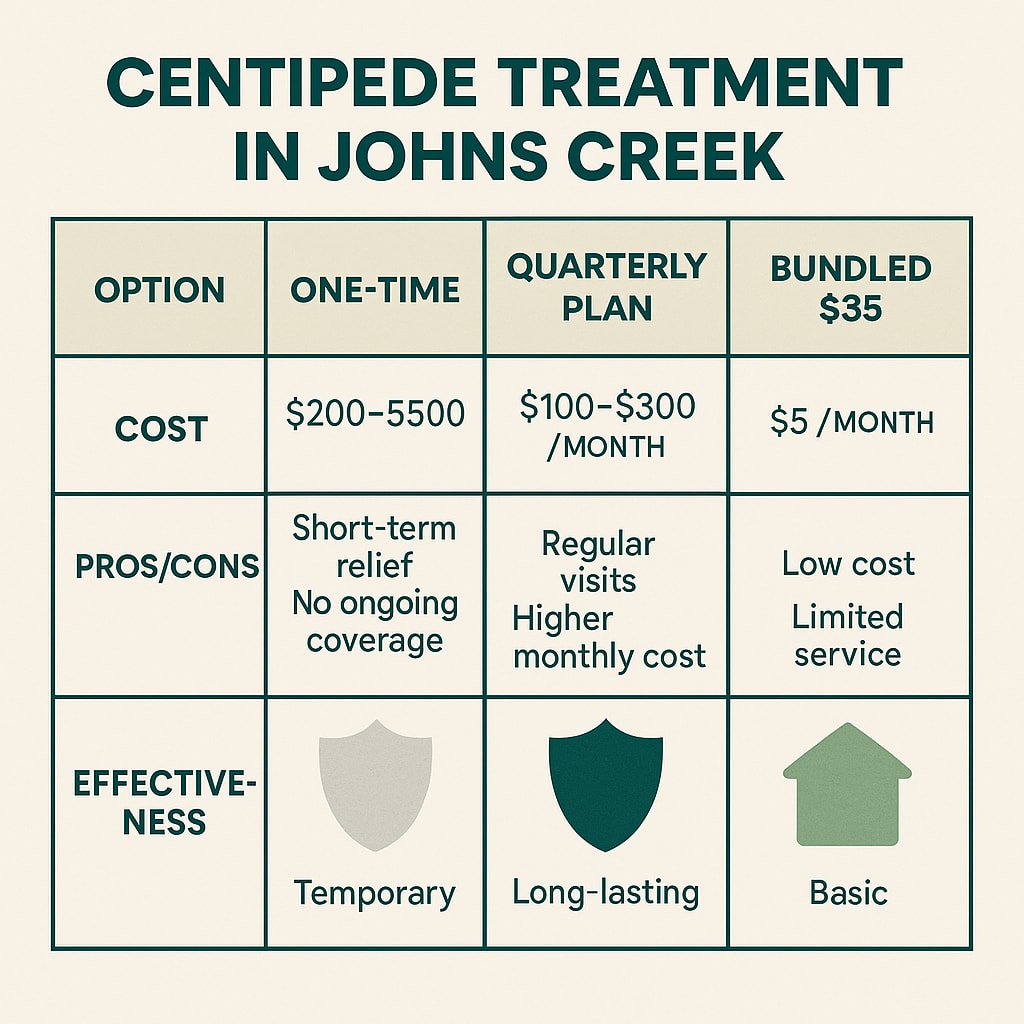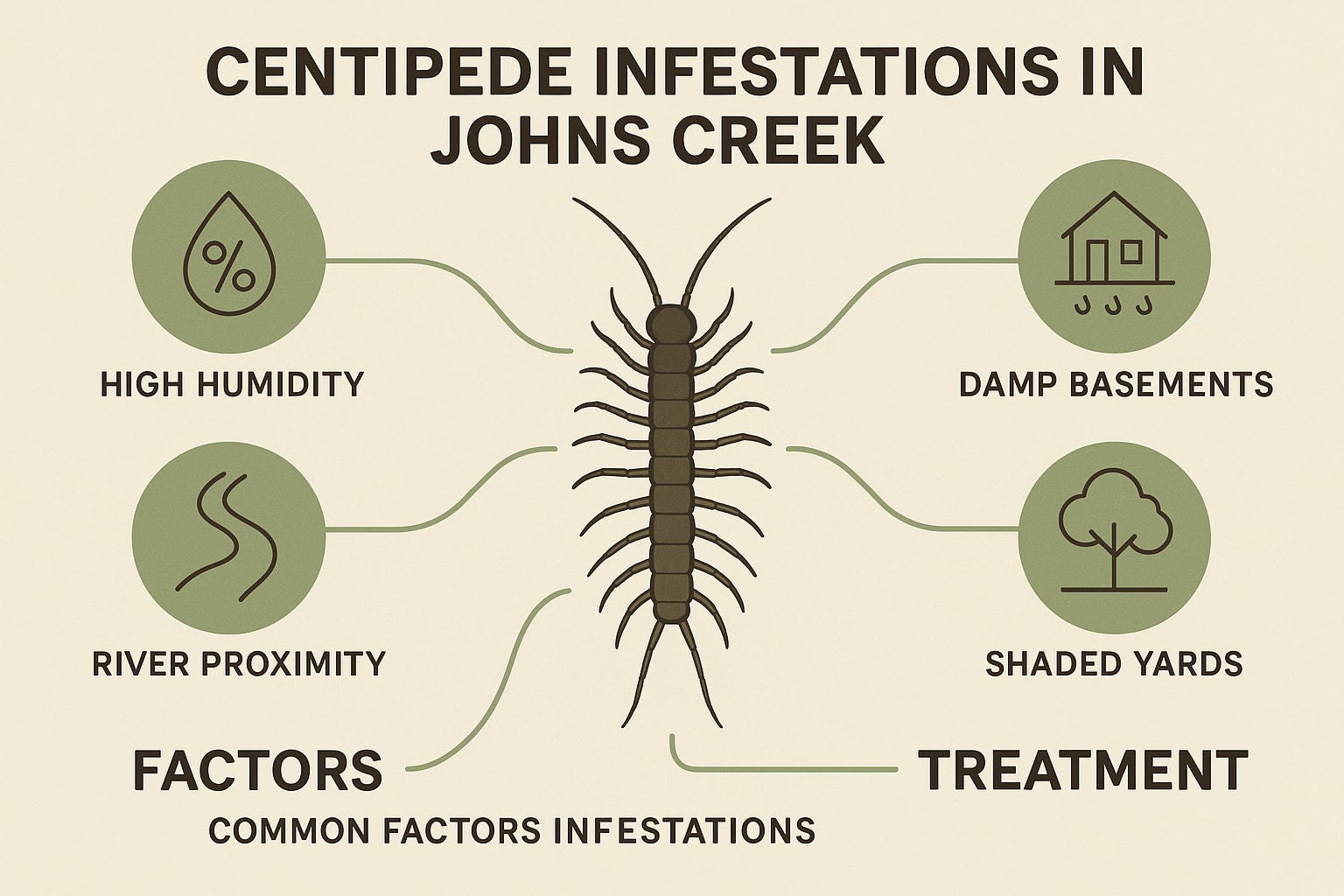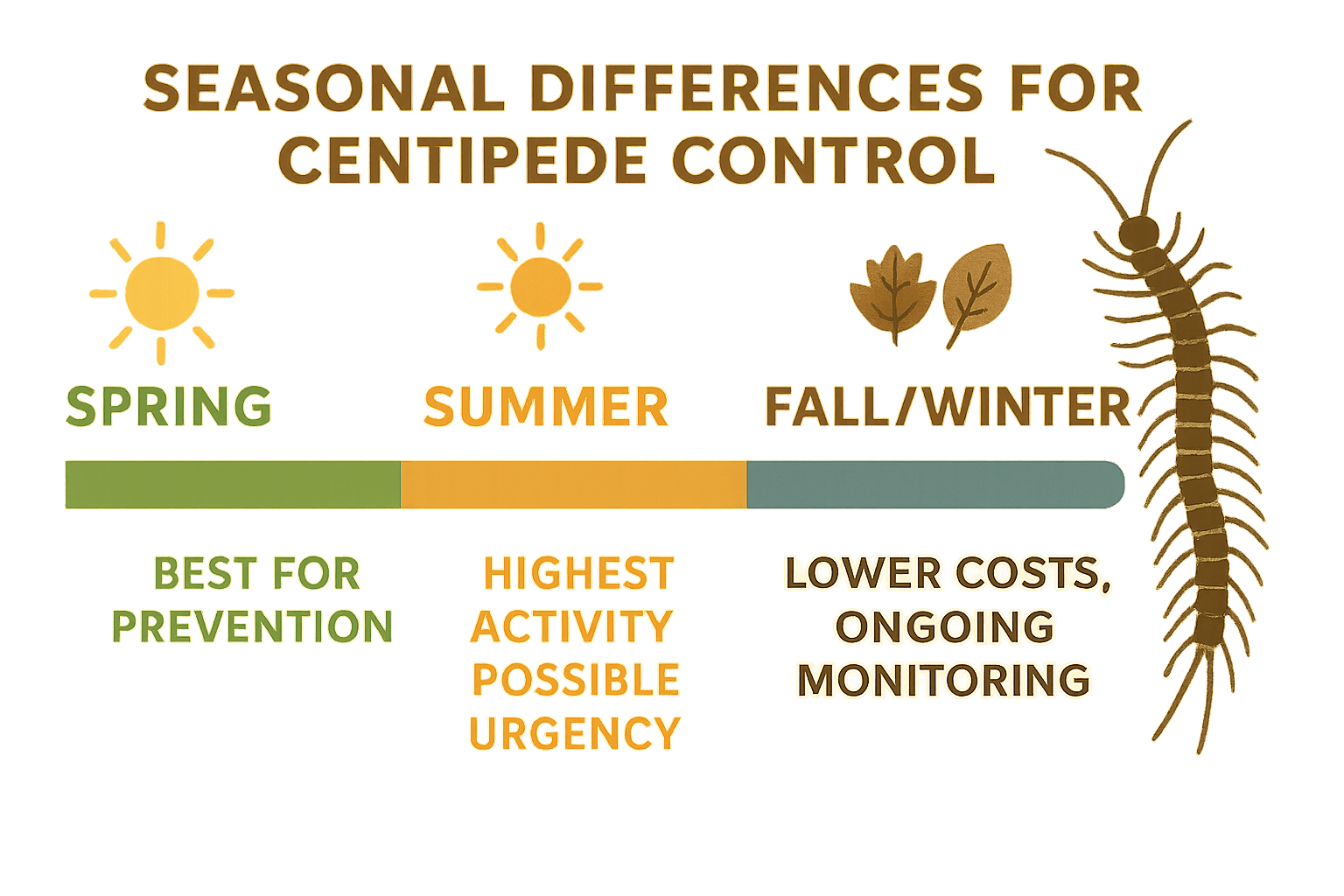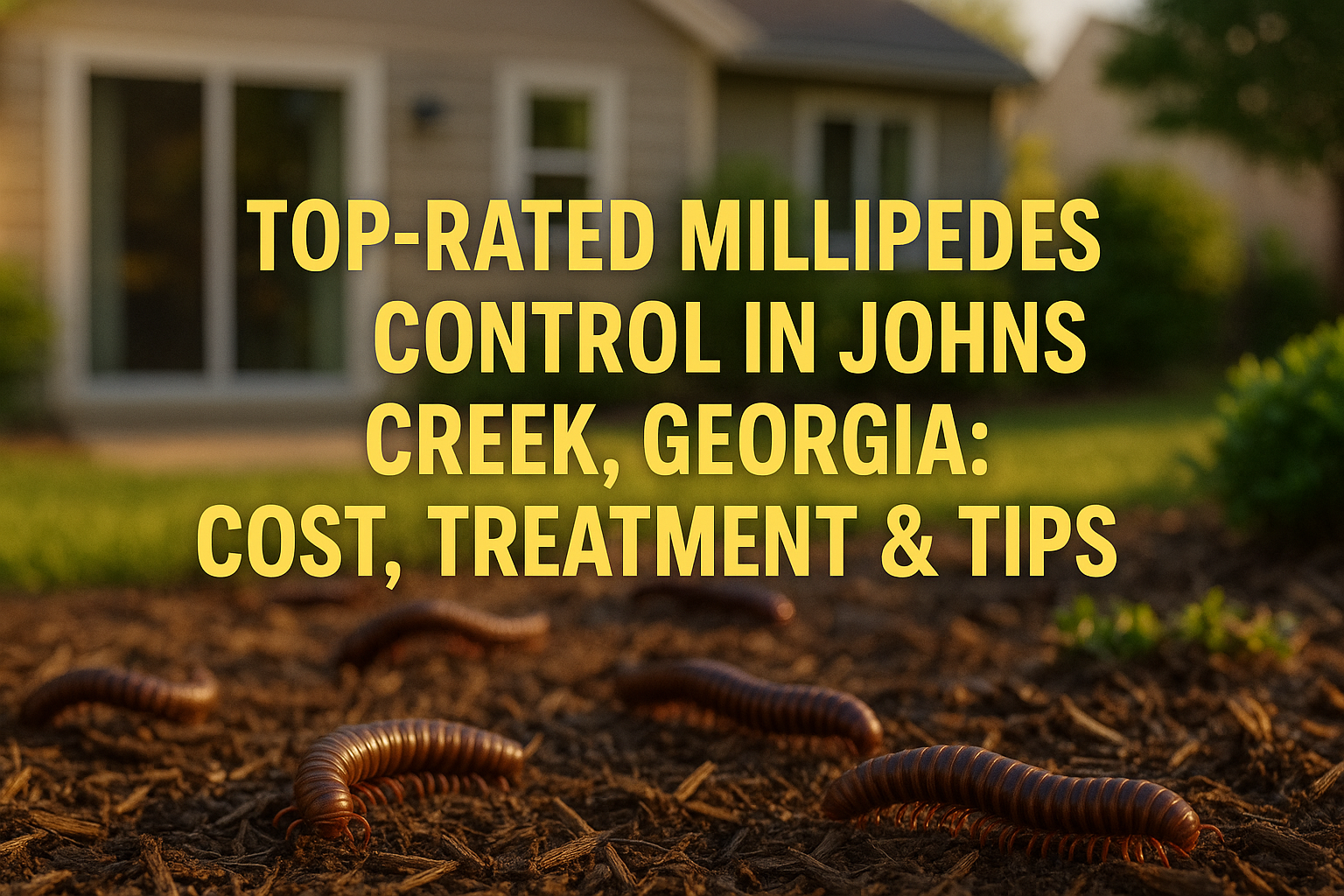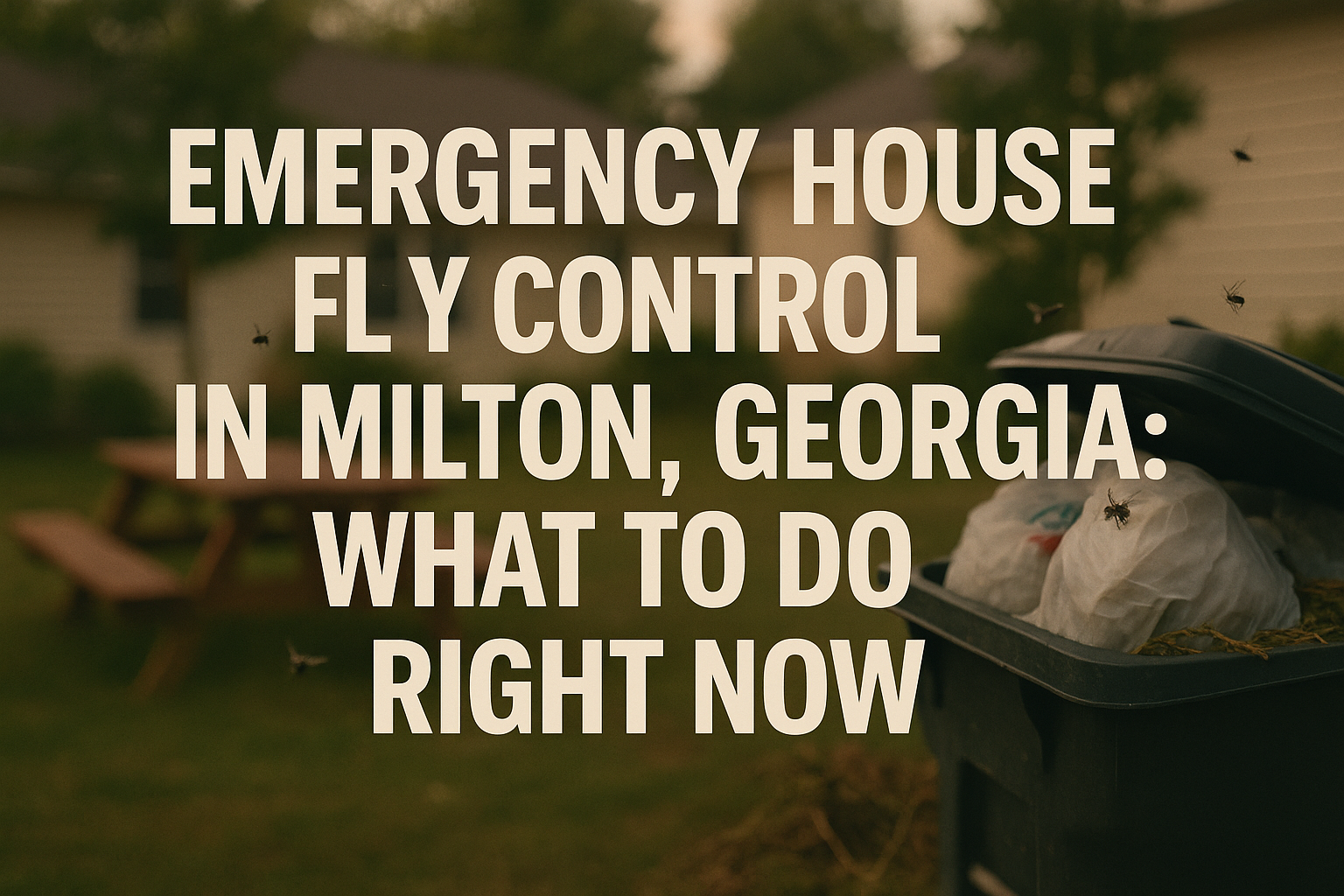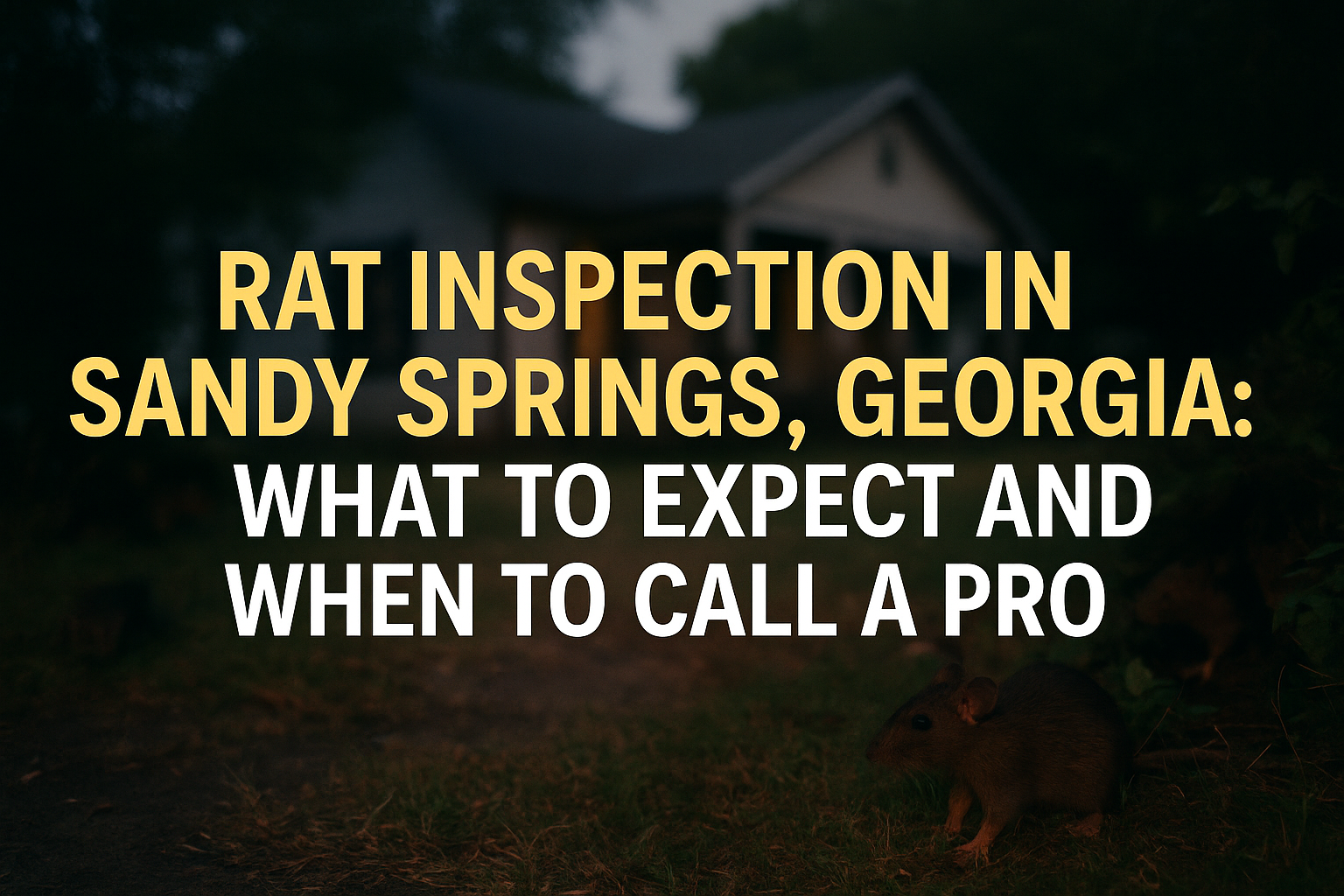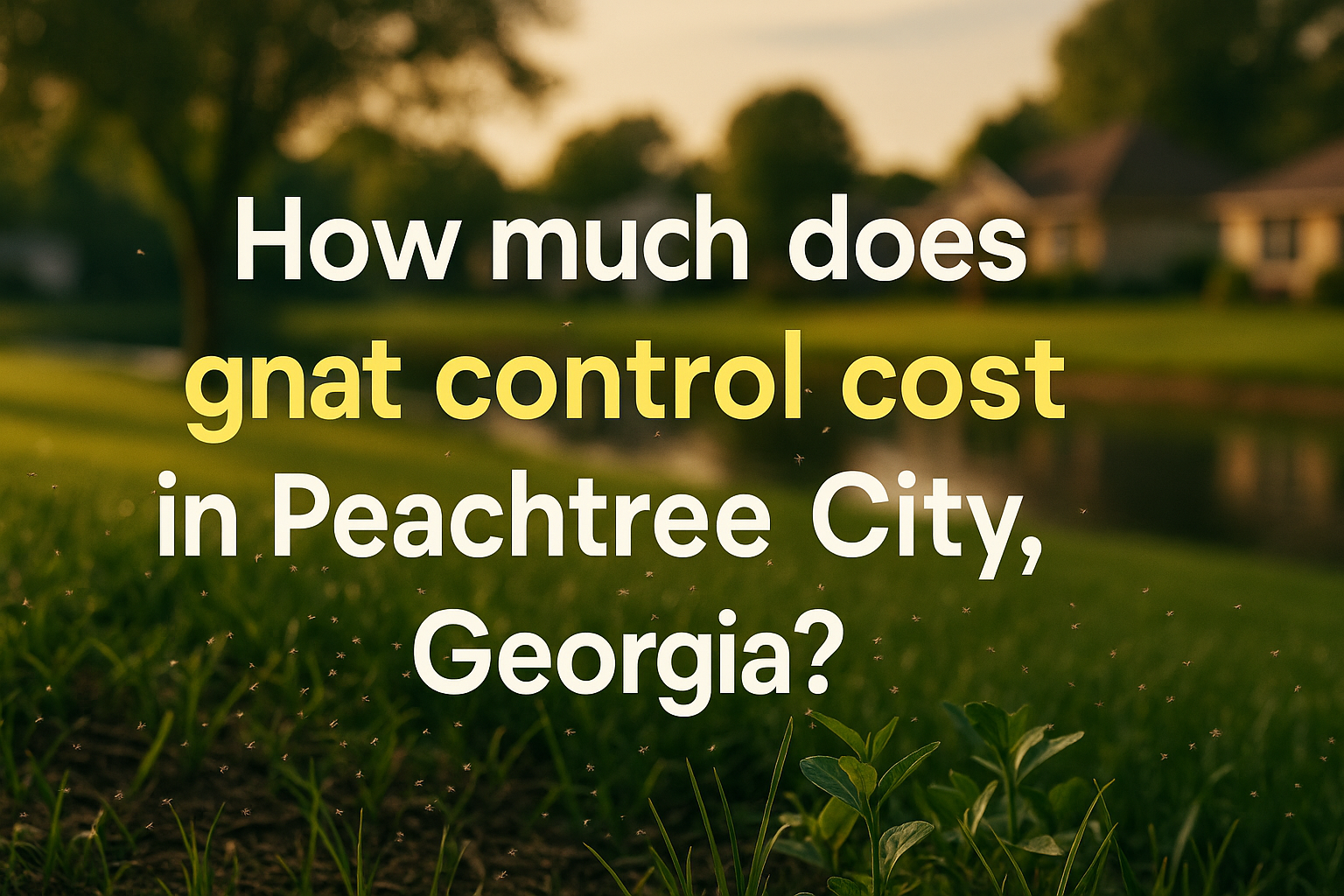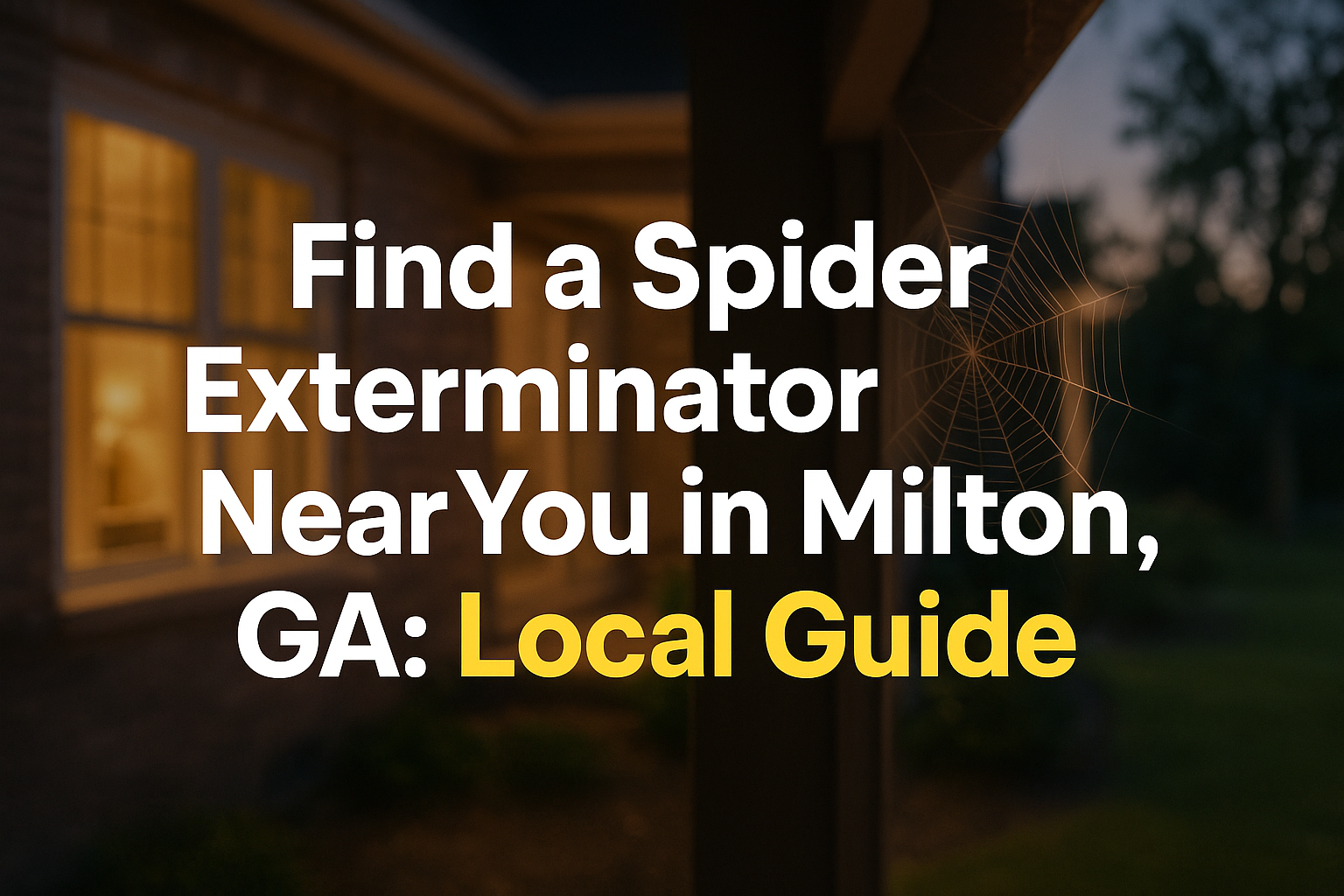Dealing With Centipedes in Johns Creek Homes
Centipede control cost in Johns Creek, Georgia, can vary—but If you’ve ever flipped on a basement light or pulled a box out of the garage and spotted a long, speedy centipede making a break for it, you’re not alone—especially here in Johns Creek, Georgia. Whether you live in Medlock Bridge, St. Ives, Seven Oaks, or anywhere else nearby, centipedes are a regular guest thanks to our area’s humidity and frequent rainfall. Johns Creek homes have the perfect mix of moisture and mild temperatures that centipedes love, so these critters tend to sneak inside seeking shelter and food.
For many local homeowners, seeing a centipede is more than just a jump scare. While they’re usually not damaging, their presence can point to damp basements, leaking pipes, or small cracks around your foundation—issues that are both annoying and can invite other pests in as well. If you’re noticing centipedes inside, odds are there’s a hidden source of moisture, and it’s worth paying attention.
When it comes to getting rid of centipedes in Johns Creek, most folks want fast, reliable relief. On average, expect to pay anywhere from $200 to $500 for a stand-alone centipede treatment. Those wanting worry-free quarterly or monthly coverage generally see costs between $100 and $300 per visit, depending on the size of your place and the severity of the problem. While the price can vary, making the investment early can help prevent a minor nuisance from becoming a bigger headache.
Let’s face it—nobody wants creepy crawlies darting around their home. Centipedes might not bite often, but when they show up, it’s natural to wonder how to get rid of them quickly and keep them from coming back. Over the next few sections, we’ll walk through different treatment options, break down current pricing for Johns Creek pest control, and share tips from local pros. By the end, you’ll know exactly how to get a handle on centipedes and keep your home comfortable.
Curious what your best plan looks like? Stick with us—we’re about to make centipede control in Johns Creek a whole lot easier for you and your wallet.
Why Centipede Control Costs Vary in Johns Creek
If you’re looking into centipede control around Johns Creek, you’ve probably noticed prices can be all over the map. There’s a good reason for that—and it’s not just pest control companies pulling numbers out of thin air. Let’s walk through what actually affects what you pay, so you know where your money goes and what to expect.
- Size and layout of your home: Live in a sprawling house out in DoubleGate or a classic two-story in Amberfield? Bigger floorplans and extra nooks simply mean there’s more ground for a pro to cover—more corners to check, more baseboards to treat, and more materials to get the job done right. The square footage or number of stories in your home matters.
- How bad’s the infestation? Spotting just a centipede or two often means a one-time treatment to knock them out and seal where they’re getting in. On the other hand, if they’re crawling out of every crevice, especially in dark, damp spots, it’ll probably take multiple visits—each one tacking on to the bill. Recurring infestations drive the price up because you’ll need a bigger, smarter plan.
- Treatment methods: There’s a big difference between a quick perimeter spray and an all-in, inside-out service with sealing up every possible entry point. Basic applications in Johns Creek start at about $200. If you want more comprehensive protection—think entry-point sealing, attic, basement, or garage work—expect numbers more like $500 or above.
- Ongoing plans and bundled services: Some folks prefer regular protection, especially those with other pest headaches. Ongoing plans can cost $100–$300 per visit, but usually these cover a range of pests with one contract, giving you more bang for your buck long-term.
- Other pests = higher price: It’s pretty common for centipedes to show up alongside spiders, roaches, or even ants. Every new pest adds complexity and cost—some materials or methods get specialized, and that bumps up the overall quote.
The best advice? Always ask your pest control pro to come out and take a look. An in-person estimate is hands-down the most reliable way to get a fair, accurate price that fits your home’s specific layout and your level of centipede trouble.
If you want to dig even deeper into how pest control pricing works here in the Johns Creek area, check out Anthem Pest Control’s detailed guide on pest control costs.
Why Centipede Control Costs Vary in Johns Creek
If you’re looking into centipede control around Johns Creek, you’ve probably noticed prices can be all over the map. There’s a good reason for that—and it’s not just pest control companies pulling numbers out of thin air. Let’s walk through what actually affects what you pay, so you know where your money goes and what to expect.
- Size and layout of your home: Live in a sprawling house out in DoubleGate or a classic two-story in Amberfield? Bigger floorplans and extra nooks simply mean there’s more ground for a pro to cover—more corners to check, more baseboards to treat, and more materials to get the job done right. The square footage or number of stories in your home matters.
- How bad’s the infestation? Spotting just a centipede or two often means a one-time treatment to knock them out and seal where they’re getting in. On the other hand, if they’re crawling out of every crevice, especially in dark, damp spots, it’ll probably take multiple visits—each one tacking on to the bill. Recurring infestations drive the price up because you’ll need a bigger, smarter plan.
- Treatment methods: There’s a big difference between a quick perimeter spray and an all-in, inside-out service with sealing up every possible entry point. Basic applications in Johns Creek start at about $200. If you want more comprehensive protection—think entry-point sealing, attic, basement, or garage work—expect numbers more like $500 or above.
- Ongoing plans and bundled services: Some folks prefer regular protection, especially those with other pest headaches. Ongoing plans can cost $100–$300 per visit, but usually these cover a range of pests with one contract, giving you more bang for your buck long-term.
- Other pests = higher price: It’s pretty common for centipedes to show up alongside spiders, roaches, or even ants. Every new pest adds complexity and cost—some materials or methods get specialized, and that bumps up the overall quote.
The best advice? Always ask your pest control pro to come out and take a look. An in-person estimate is hands-down the most reliable way to get a fair, accurate price that fits your home’s specific layout and your level of centipede trouble.
If you want to dig even deeper into how pest control pricing works here in the Johns Creek area, check out Anthem Pest Control’s detailed guide on pest control costs.
Why Centipede Problems Are So Common—and Complicated—in Johns Creek
If you’ve ever wondered why centipedes seem to pick Johns Creek as their favorite hangout, you’re not alone. Our humid, subtropical climate—think muggy summers and regular rain showers—sets the perfect stage for these critters. Whether it’s the thick mulch in the flowerbeds or the shaded corner of your backyard, areas that hold onto moisture are practically an open invitation for centipedes.
Homes around neighborhoods like Farmbrook or River Farm face their own set of challenges. Older houses, often full of character, can also have tiny cracks in the foundation, aging pipes, or unfinished basements that offer centipedes plenty of ways to sneak inside. Even newer construction isn’t completely off the hook—modern insulation might keep you comfy, but basements and landscaping that hold dampness still draw in these pests.
The soil in our area, packed with river silt and the occasional Georgia red clay, holds water longer than you might suspect. Couple that with properties lined by woods or close to the Chattahoochee River, and you’ve got a recipe for ongoing moisture. Centipedes love those damp, shaded areas and—let’s be honest—they know how to find them.
This all means that treating centipede infestations here isn’t always a simple, one-and-done job. Sometimes, you’ll need extra visits for ongoing treatments, moisture barriers to dry things out, or special products that can handle our unique local conditions. These extras can impact the total cost of service, especially if a property’s structure or location makes centipedes tough to keep away for good.
Want to really see how these factors come together? Check out our upcoming infographic for a visual breakdown of how Johns Creek’s local mix of weather, soil, water, and home styles makes centipede control a little more involved—and why professional help is often the smartest call.
Smart Moves to Keep Centipedes Control Costs Out of Your Johns Creek Home
If you want to keep those creepy-crawly centipedes from making themselves at home—and save money while you’re at it—it’s all about some smart, simple habits. First, get ahead of that sticky Georgia humidity. Basements and crawlspaces are prime spots for moisture, which centipedes love. Grab a dehumidifier, fix up any leaky pipes, and make sure crawlspaces are getting plenty of airflow. Little things like this help dry out the places centipedes use for hideouts.
Yard clutter is practically a party invite for bugs. Rake up those leftover leaves, keep wood piles away from your foundation, and try to keep shrubs and landscaping from hugging right up to your house. Fewer hiding spots mean fewer pests showing up at your door.
Next up, be on the lookout for cracks and gaps around your windows, doors, and anywhere utilities come in. Seal those up tight with caulking or weatherstripping that’s meant to keep pests out. This not only blocks centipedes, but cuts down on all sorts of bugs—and even helps with your energy bills.
Want to really keep costs low? Don’t wait for a creepy-crawly surprise. Schedule regular pest inspections, especially before spring gets into full swing. Local companies, like Anthem Pest Control, often offer package deals or discounts for routine checks. Catching a tiny problem early is always easier on your wallet than dealing with a big outbreak down the line.
- Reduce indoor moisture with dehumidifiers and repairs
- Keep foundation clear: rake leaves, store wood away, trim landscaping
- Seal up cracks and entry points to block invaders
- Book spring pest inspections to nab deals and catch issues early
Make these steps a routine and you’ll feel the difference—not just in pest activity, but in savings. Next, we’ll talk about the best times of year for these moves (and how to stretch your budget further), plus a simple checklist to keep everything on track all year long.
When’s the Right Time for Centipede Control in Johns Creek?
If you’re dealing with centipedes or worried about them sneaking into your Johns Creek home, timing really can make all the difference. The smartest locals usually jump on preventive treatments in early spring, just as those first warm days arrive. Centipedes come alive with the season, so catching them before they pick up steam lets you stop a minor issue before it turns into a summer invasion. Plus, prices are generally better before the rush hits, when everyone starts spotting these critters indoors and trying to book urgent service.
Come summertime, demand for centipede control spikes—along with prices—since infestations are at their worst. No one wants to wait when bugs are wriggling across your floor, so acting early saves you both hassle and money. Don’t overlook fall, either. When temps cool down, centipedes slow way down too, which makes this a clever window to get budget-friendly treatments. A lot of pest companies in Johns Creek offer solid off-season deals to keep their crews busy as things quiet down.
Lived here a while or have a house by the river or with a lot of shady greenery? Year-round monitoring can be a lifesaver, especially if you want peace of mind. Spotting that first centipede inside is another clear sign it’s time to call for service—don’t wait for a full-blown problem.
- Best value: Schedule in early spring for prevention and discounts.
- Fall opportunity: Book after peak season for possible lower rates.
- Urgency: Act fast if you see centipedes indoors—infestations accelerate quickly.
- Extra caution: Homes near water or heavy foliage benefit from year-round protection.
If you missed the spring window or need help deciding, check the seasonal comparison infographic above to see what fits your situation best. A little strategic timing goes a long way toward keeping your home centipede-free—and your budget happier.
Take Control of Centipedes—Starting Today
If you’re seeing more centipedes than you’d like in your Johns Creek home, now’s the perfect time to nip the problem in the bud. Don’t let a minor nuisance turn into a real headache—protect your space and your peace of mind with help from locals who care. Anthem Pest Control is ready to give your place a thorough check, absolutely free, with no strings attached. We’ll explain exactly what’s going on and share a clear quote based on your home’s size and your neighborhood—no surprises.
Give us a ring at 877-3718-5196 or visit our website to get your personal quote and practical advice. Our friendly Johns Creek experts make centipede control simple and worry-free, so you can get back to enjoying your home. Don’t wait until the little pests get out of hand—call or click today and see how easy it is to protect your home for good.
Common Questions Johns Creek Homeowners Ask About Centipede Control
It’s completely normal to have a few questions before deciding how to tackle a centipede situation at home. Here’s what other homeowners in Johns Creek are usually curious about—and the answers you need to make the right choice for your family and your property.
- What keeps bringing centipedes into my house? Centipedes are always on the hunt for damp, cool, and dark places. If you’ve got mulch piled up outside, leafy beds, or a basement with some extra humidity, you’re basically rolling out the welcome mat for these pests. Sealing up cracks and cutting back on yard clutter makes your home a lot less appealing.
- Will centipede treatment help knock out other bugs? Absolutely. The truth is, most pest control plans—including what we offer and what reputable companies in the area use—work on a bunch of different creepy crawlies, not just centipedes. You’ll often see fewer roaches, spiders, and other bugs as a bonus.
- Is it safe if I have kids or pets? Safety comes first. Pros use products that meet strict EPA guidelines, and always apply with caution around people and pets. If you’ve got little ones crawling around or curious pups, we take steps to keep everyone safe and sound.
- How soon will I notice fewer centipedes? Most folks in Johns Creek tell us they see a big drop in centipedes within a few days of their first treatment. If you’re dealing with lots of them, expect full results after about a week or two.
- What if they pop back up later? Sometimes centipedes can sneak back in, especially if the source (like a leaky pipe or piles of debris) isn’t dealt with. That’s why a recurring service plan is the best bet if you want to keep them out for good.
- Do I need ongoing service, or is one visit enough? If it’s just an occasional bug here or there, a single treatment might do the trick. But if you’re seeing centipedes more often, recurring service is best—especially here in Georgia, where our humidity keeps them comfy year-round.
- Will the price be different where I live? There can be slight cost differences depending on your neighborhood and just how tricky access is. Homes near rivers, wooded lots, or areas with thick undergrowth sometimes need more intensive attention, so there could be a small price bump in those cases.
If you’ve got your own questions or want advice tailored to your specific situation, give us a shout. We’re here to help you feel comfortable and confident in your centipede control choices!


